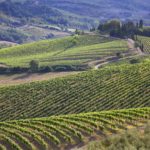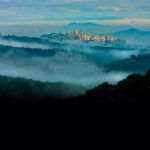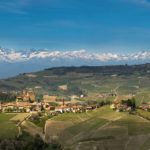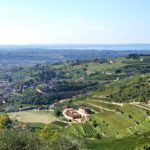At the dawn of wine tourism

In the 1990s, wine tourism was not yet recognized as a distinct market segment in Italy. International visitors came for the art and history, for beautiful cities, the sea, and mountains, and for business trips, and while they may have been attracted to Italian cuisine, olive oil, and wine, very few wineries were open for tastings at that time. Little by little, the Italian wine sector recognized the potential for wine tourism. Organizations like Movimento Turismo del Vino and Le Donne del Vino (women of wine) started promoting winery visits, sommelier associations opened courses to wine lovers, Italian wine consortia began to market their regions as wine travel destinations, and media attention grew around gastro-tourism. National tourism campaigns highlighted Italian wine, food, and lifestyle, while wineries realized the benefits of promoting and building their brands and selling wine directly to estate visitors.
The evolution of winery hospitality.

Today, for every 10 tourists who choose to visit Italy, two do so specifically for the wine. The wine tourism sector of Italy, which attracts 15 million annual visitors and a turnover of 2.5 billion euros, has been experiencing steady growth for years, with no signs of slowing down. These numbers confirm and consolidate Italy’s leadership in the diverse world of wine-related travel. This success cannot solely be attributed to the fame and positioning of our country’s wines; rather, it stems from the close connection between production and territory – aspects that must always remain interconnected and developed through unified strategies and directions. On one hand, there is emphasis on product quality and customer loyalty, aiming to meet both the material and immaterial expectations of consumers. On the other hand, there is significant investment in the places of production, with territorial or regional brands offering high standards of hospitality and providing experiences that deepen an understanding of the territory from which the wine “originates”. In essence, this approach creates a solid and lasting reputation, linking one or more labels with the places that host them in a symbiotic relationship where the value of one enhances the value of the other. With this perspective, it’s easy to understand Italy’s leadership in wine tourism. The abundance of prestigious locations, its centuries-old winemaking tradition, deep connections between small producers and big brands, and cohesive territorial communities rich in history and culture – Italy has all the ingredients to continue writing a success story.

Wineries have been the protagonists of this transformation and, over the last 25 years, have evolved from simple production sites into coveted tourist destinations for wine enthusiasts and professionals from all over the world. Today, hospitality in wineries is no longer a secondary occupation of the winemaker’s trade but a primary activity that significantly contributes to business sustainability, requiring dedicated planning and organization. While there have been considerable advancements, they have not yet fully compensated for some of the shortcomings that hinder the competitiveness of the sector: the quality of national transportation infrastructure, inadequate training of staff dedicated to promotion and communication, low propensity for territorial aggregation, delayed enhancement of existing tourism offerings (even at the level of individual producers), and limited investments in technologies to improve the hospitality experiences for wine tourists. Despite these shortcomings, Italy remains a preferred destination for wine tourism on a global scale. In this context, both the giants of the national wine industry and the small, lesser-known family-run wineries have become aware of the integrated approach between production, sales, and hospitality. From the Alps to Sicily, wine lovers now have tailor-made hospitality offerings at their disposal, often personalized, ranging from tastings at the counter to luxury vineyard picnics, from dinners with Michelin-starred chefs to access to old vintages. While some establishments have invested in winery hospitality for day-trippers, there is a growing trend of “gourmet” travelers wanting to stay amidst the vines. Therefore, within wineries, high-quality agritourism, charming relais, high-end resorts, and rooms and suites with breathtaking views of the vineyards have sprung up throughout the country.
A digital approach to winery experiences.

Turning our gaze to the present, the digital realm has brought a wave of innovation to the wine tourism sector as well. On one hand, wineries are leveraging computer tools such as artificial intelligence, digital marketing, and customer relationship management (CRM) to analyze information, understand the behavior of wine lovers, and identify market opportunities. On the other hand, there are wine tourism portals or platforms. These are true marketplaces where wine enthusiasts can purchase, in addition to the classic tastings at the winery, unique experiences that encompass the entire world of winery hospitality. The benefits of technological evolution and a digital approach for wineries are evident: increased web visibility, improved reservation management, and a positive impact on direct sales, including wine tourism experiences. This strategy paves the way toward the future, opening up the market to new target customers such as younger generations, who are particularly drawn to experiences with a strong technological foundation.
Customized wine tours for a niche clientele

Today, wine tours are increasingly attracting luxury world travelers, or rather, those who are willing to pay high amounts for an exclusive and unique experience. These consumers are seeking tailor-made journeys that highlight the pleasure of refined cuisine and fine wines, amidst restaurants and taverns or rooms with views of the vineyards. Such bespoke experiences are designed for even the most discerning of clients, including private collectors, bidders at wine auctions, groups of industry professionals, and wine clubs from around the world. This target audience requires extreme quality management, relying on the best professionals in the field – specialized tour operators capable of meticulous planning and interpreting the desires and interests of travelers to the fullest. Federico Moccia, head sommelier of Pall Mall 67, an exclusive wine club in London with branches in Bordeaux, Beaune, Verbier, Singapore, and Melbourne, confirms the validity of this approach: “We have chosen Italy, relying on an industry expert for planning. We decided to discover Bolgheri first and then the Langhe as official wine tour destinations for our members. And we will continue to travel to other regions because the Beautiful Country has a special allure in terms of the beauty of the places, authenticity of the wines and the people, starting with the producers.” These words echo those of Philip Goodband MW, which we hold as a manifesto to conclude our journey through the past, present, and future of wine tourism in Italy: “The wine journey in Italy is a cultural enrichment that never ends. I started leading groups of collectors first in Tuscany and Piedmont, then in Veneto and Trentino Alto-Adige. After a stop in Umbria and a glance at Abruzzo, I will soon head south, between Campania, Puglia, and Sicily, the homeland of great wines and a millennia-old history. This is the Italy that I love and that fascinates me.”